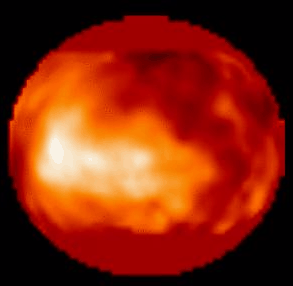
|
Explanation: The surface of Titan, Saturn's largest moon, is normally hidden from view by its thick, hazy atmosphere. However, for the first time astronomers have been able to see surface features in images like the one above, made at near-infrared wavelengths with the Hubble Space Telescope. At these wavelengths (longer than visible light) Titan's smog like atmosphere begins to be transparent enough to allow glimpses of it's surface. The bright feature seen above is about 2,500 miles across, similar in size to Australia. Astronomers are still trying to work out what the bright and dark areas represent - oceans, continents, craters, or other features. The images represent important information for planning the Cassini mission, scheduled for launch in 1997. The Cassini spacecraft will explore the Saturn system and parachute a probe to Titan's surface.
|
January February March April May June July August September October November December |
| |||||||||||||||||||||||||||||||||||||||||||||||||||||||
NASA Web Site Statements, Warnings, and Disclaimers
NASA Official: Jay Norris. Specific rights apply.
A service of: LHEA at NASA / GSFC
& Michigan Tech. U.
Based on Astronomy Picture
Of the Day
Publications with keywords: Titan
Publications with words: Titan
See also:
